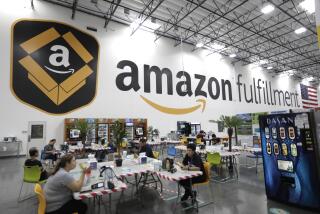Amazon robots speed customer orders but may lead to fewer workers
This holiday season, Amazon’s little helper is an orange, 320-pound robot called Kiva.
The robots — more than 15,000 of them companywide — are part of Amazon’s high-tech strategy to get orders to customers faster. By lifting shelves of Amazon products off the ground and automatically delivering them to employee stations, the robots cut the time it takes for warehouse workers to walk around looking for items.
But a growing army of robots at the country’s biggest e-commerce retailer could spell trouble down the line for many of the thousands of employees at Amazon’s 109 warehouses. Amazon’s moves to revolutionize operations could also have implications industrywide if smaller companies feel forced to similarly adapt to compete.
“Real-life workers are going to have less to do,” said Michael Pachter, an analyst at Wedbush Securities. “It’s obvious that humans are going to lose these jobs. There will be exactly the same impact on retail as robots have had on manufacturing.”
During a tour of Amazon’s year-old fulfillment center here Sunday — the first time media were allowed to get a close-up look at the Kiva robots and Amazon’s latest warehouse model — the company sought to dispel worries about the rise in automation.
“We continue to add employees, and no employee has been negatively impacted by Kiva coming on board,” said Dave Clark, Amazon’s senior vice president of worldwide operations and customer service. He noted that Amazon hired 80,000 seasonal workers for the holidays, up 14% from a year earlier.
The Tracy warehouse, about an hour east of Oakland, was pulsing with activity on the eve of Cyber Monday as humans and machines worked side by side to prepare for one of the biggest shopping days of the year.
Kiva robots zoomed around four floors with uncanny precision, hoisting shelves laden with video games, coloring books and stuffed animals. Yellow bins filled with completed orders zipped by on conveyor belts. A group of employees, some sporting red Santa hats, took a break from sealing boxes to do a series of arm stretches.
Since acquiring robot-maker Kiva, a Massachusetts company, for $775 million in cash in 2012, Amazon has been increasingly implementing automation at its gargantuan fulfillment centers. Kivas, which resemble overgrown Roombas, are capable of lifting as much as 750 pounds and silently glide across Amazon’s warehouse floors by following rows of sensors.
The Tracy facility has the company’s latest “eighth-generation” fulfillment center technology, including 3,000 Kivas. Ten Amazon warehouses, including two in California, are classified as eighth-generation.
Clark said that because Kiva-equipped facilities eliminate the need for wide aisles for humans to walk down, eighth-generation centers can hold 50% more inventory than older warehouses. More storage capacity means a wider selection of merchandise, fewer chances of products being out of stock and more possibilities for same-day delivery, he said.
“It’s sort of a virtuous cycle,” he said. The robots, he added, have also cut processing times for orders to as little as 13 minutes from well over an hour.
He said increased automation hasn’t led to reduced staffing levels at newer warehouses because the company continues to grow rapidly, which has led to more hiring.
“When you look around at Kiva, there’s still a lot of people working,” Clark said. “What we’ve done is automate the walking element. Our focus on automation is to do automation that helps employees do their job in an easier way, in a more efficient manner.”
That may be true for now, but Amazon’s robots are already doing tasks humans would otherwise do, which over time will “almost assuredly” lead to fewer lower-wage workers, said Harley Shaiken, a professor and labor expert at UC Berkeley.
“The notion of robots is meant to replace workers; it’s meant to lower labor costs,” he said. “Just saying no one has ever been negatively affected doesn’t tell us much about what the future looks like.”
Since at least the early 1970s, labor productivity and employment in the U.S. have risen practically in tandem. That changed in the early 2000s, when productivity began to outpace employment, so far at an ever-widening rate.
Although Amazon maintains that it is still actively hiring in droves, it’s an open question whether the rapid hiring due to fast growth makes up for jobs lost as work is automated. Few economists, however, dispute the idea that automation increasingly makes low-skill human labor unnecessary. It’s not just an Amazon issue — it’s a problem that affects the entire economy.
But there are upsides. For shoppers, the cost savings and greater efficiency will mean continued low prices for Amazon goods, delivered at even faster speeds.
Because robots can’t replicate everything humans do, such as being able to identify the exact product a customer has ordered and check it for quality, hordes of employees will still be needed. Those jobs will tend to be higher-paid ones: While robots handle the more menial, labor-intensive tasks, skilled workers will be needed to operate, maintain and program the fleet of state-of-the-art machines.
About 4,000 employees work out of the Tracy facility, 2,500 of them hired for the holiday season rush. Amazon has projected sales during the fourth quarter to increase 7% to 18% compared with the same quarter last year.
The warehouse, which is more than 1 million square feet in size, is still not at full capacity. It houses 21.5 million items (3.5 million unique SKUs), with plans by Amazon to increase that number to up to 27 million items next year. On a peak day — such as Cyber Monday — the fulfillment center ships 700,000 products.
Workers at the facility said they enjoyed the ease of Kiva robots bringing products directly to them, though some conceded they missed navigating the former maze of aisles to find products.
Clark declined to discuss the cost of each robot, or how much Amazon spent building the Tracy warehouse. But, he noted, “we’re very happy with the economics.”
Seattle-based Amazon is still in the early stages of warehouse automation and has been rolling out several tech upgrades. Some facilities use Robo-Stow, a six-ton robot that moves merchandise pallets as high as 24 feet onto Kiva robots, and “vision systems” that can confirm each item in an entire trailer of inventory in as little as 30 minutes by capturing an image of the trailer’s contents.
More to Read
Sign up for Essential California
The most important California stories and recommendations in your inbox every morning.
You may occasionally receive promotional content from the Los Angeles Times.










